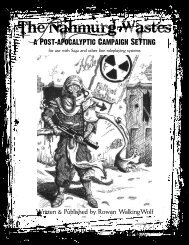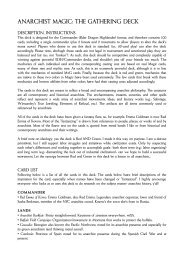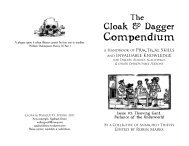Hyboria - WordPress.com - Yggdrasil Distro
Hyboria - WordPress.com - Yggdrasil Distro
Hyboria - WordPress.com - Yggdrasil Distro
Create successful ePaper yourself
Turn your PDF publications into a flip-book with our unique Google optimized e-Paper software.
Stygian<br />
"Occasionally a bronze chariot rumbled along the flags, and there was a brief glimpse of a tall, hawk-faced noble,<br />
with a silk cloak wrapped about him, and a gold band with a rearing serpent-head emblem confining his black<br />
mane; of the ebon, naked charioteer bracing his knotty legs against the straining of the fierce Stygian horses."<br />
- Robert E. Howard: "The Hour of the Dragon"<br />
Known as the "Serpent of the South", Stygia is a decadent theocracy and is characterized by being<br />
xenophobic, inscrutable, and obsessed with the subjects of death and immortality. To the <strong>Hyboria</strong>n races,<br />
Stygia represents a sinister, sorcerous menace, a black land of nameless horror whose cult of the fanged<br />
serpent god, Set, is looked upon with cold dread. To the Stygians, the <strong>Hyboria</strong>ns are heathen fools.<br />
Stygia came into being when the ancestors of modern Stygians drove westward and conquered the land<br />
from the snake men who built the black pyramids and the haunted tombs beneath the pyramids.<br />
Contemporary Stygians are a mysterious people whose society is<br />
strictly organized in a class system dependant, by and large, upon<br />
physical types. The royalty and the most ancient nobles are<br />
relatively tall people with black hair and fair skin. Below these, the<br />
ruling elite of aristocrats and a powerful middle class are duskyskinned,<br />
hawk-nosed men, haughty of mien. The lowest classes are<br />
peasants and slaves of hybrid stock, a mixture of Kushite, Shemite,<br />
<strong>Hyboria</strong>n, and Stygian ancestry.<br />
Stygian society is dominated by the priesthood. The chief god of<br />
the Stygians is Set, the Serpent God, whose influence has stretched<br />
from the lands of Stygia into nearly all other lands. The population<br />
is notably small, for, despite its size, there is little arable land, and<br />
that is mostly along the banks of the River Styx (also called Nilus).<br />
Rarely will a Stygian venture from his own lands. Even more<br />
rarely will an outsider enter his, as it is death for one who is not a<br />
Stygian to enter a Stygian city. Any wanderers found inside<br />
Stygian territory are killed. This may be done unceremoniously, or<br />
it may involve a sacrificial ritual. The Stygians have never been<br />
known to allow captured trespassers to live. The only exception to<br />
this rule is the harbor-city of Khemi, where foreign merchants are<br />
allowed entry during the day, but must return to their ships at<br />
night. Stygian Archers<br />
The Stygians have developed an economy based on nomadic herding, fishing, and harvesting the palm<br />
date; major industries include the production of sorcerous charms and amulets, as well as drugs and<br />
pharmeceuticals for both medicinal and magical use. Silk and steel arms are also manufactured here and<br />
are sought after for trade by the merchants who travel the numerous caravan routes across the nation.<br />
The Stygians are less effective with iron than the cultures of the west and far east, but they are great<br />
masters of bronze and ivory. Their treasures are ancient, and tell of a time when Stygia was far grander<br />
than the dusty ruins found today reveal. Their land is one of forgotten mystery, but it is known that their<br />
31







